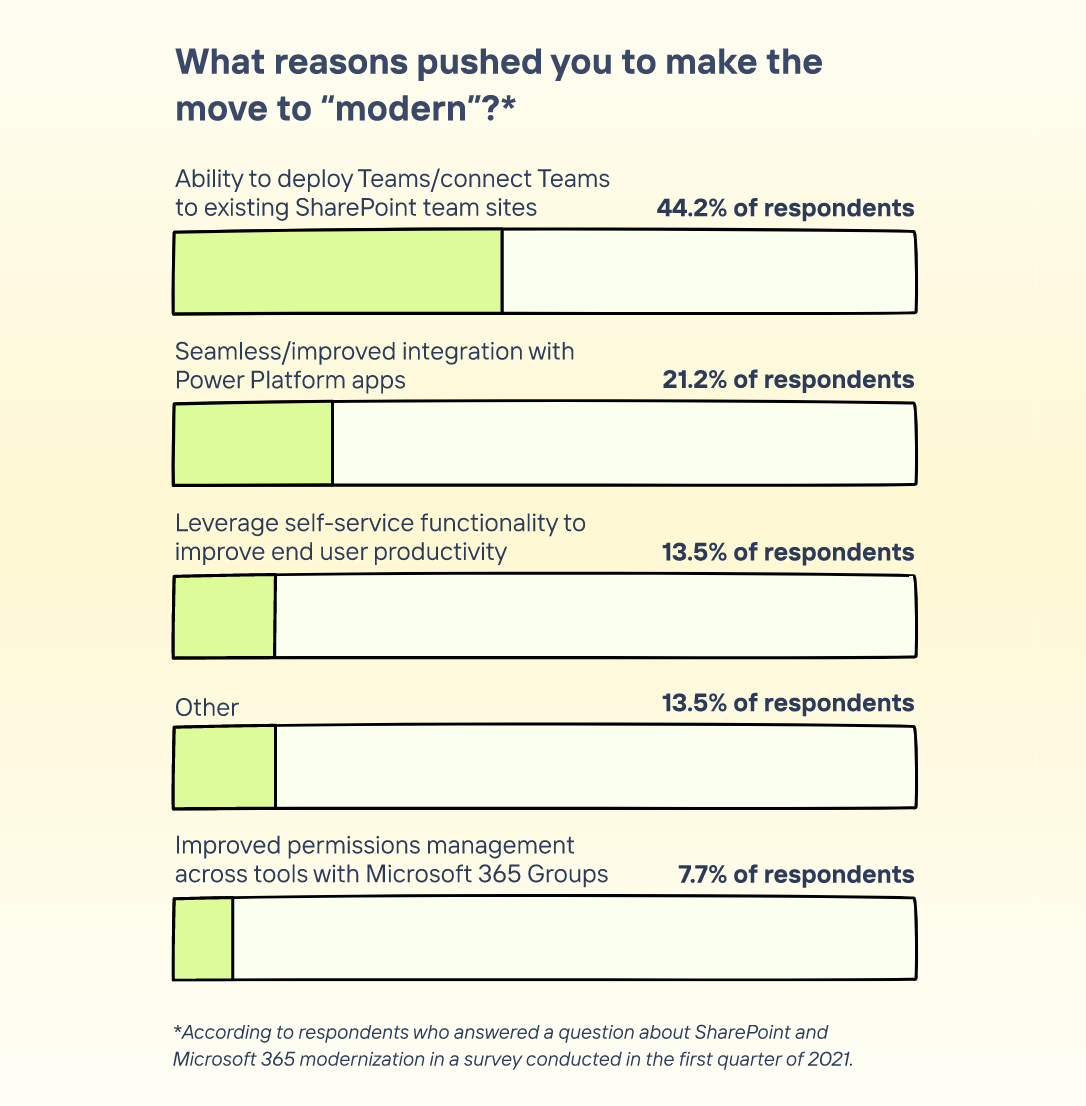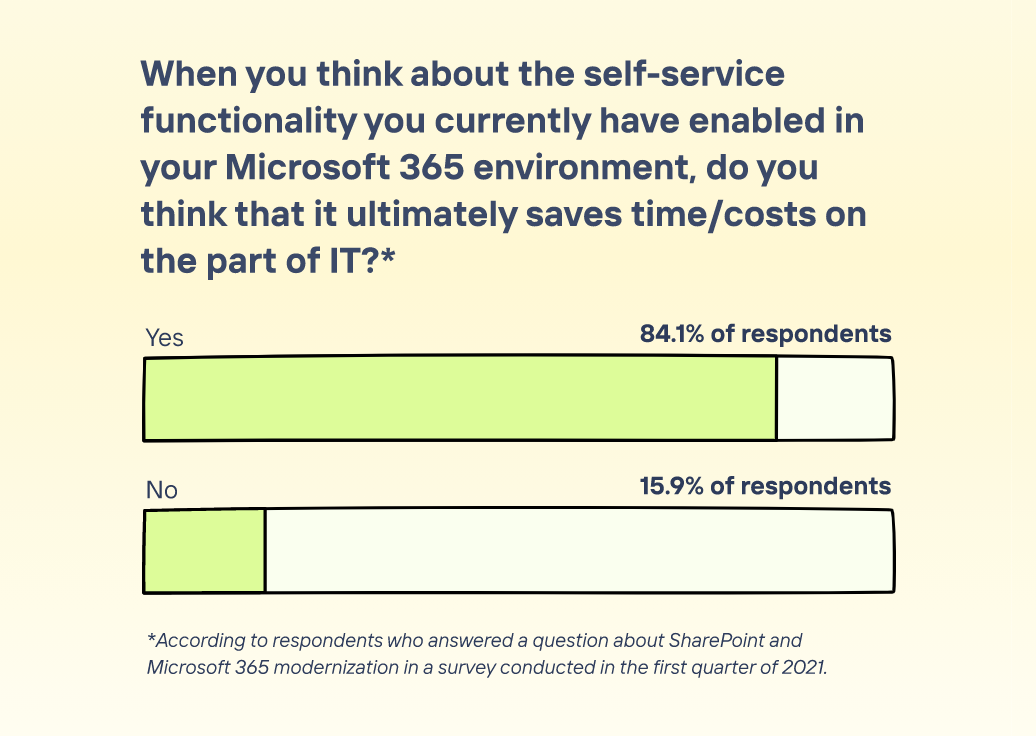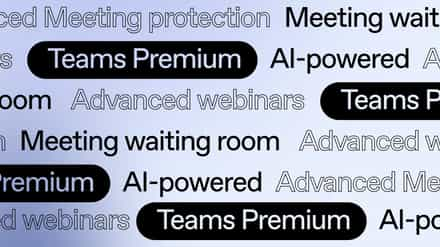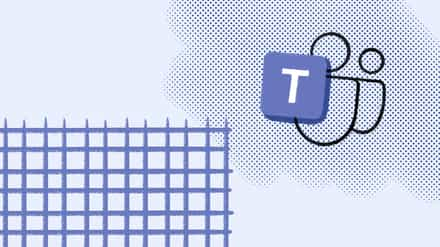Microsoft 365’s productivity suite is designed for users to benefit from new ways of working. Here are the top reasons why remote teams should go all in and fully adopt Microsoft’s modern workplace.
In a survey conducted for our cloud computing report, State of Microsoft 365: Migration, Modernization, and Security in 2021, 92.8% of IT professionals said they fast-tracked their pre-existing modernization plans in 2020 due to COVID-19.
Unfortunately, the sudden requirement to social distance meant they needed to shift quickly to working remotely in virtual collaboration spaces. In response, organizations scrambled to invest in productivity tools that could make effective digital communication possible to keep their operations running smoothly in that new environment.
Enter Microsoft’s modern workplace products, which offer a powerful option for an effective digital transformation.
Table of contents
What is Microsoft’s modern workplace?
The Microsoft 365 “modern workplace” concept offers organizations a new way of working and operating. At its core, it’s about employee empowerment, embracing online collaboration, and helping your team use technology to work securely anywhere and anytime.
To achieve that dream, organizations need the appropriate modernized IT infrastructure that can evolve as they grow. Luckily, Microsoft offers everything businesses require to create a more integrated, agile collaborative work environment, all using its cloud-based services and tools. With many options for customization, businesses can also experience seamless integration between this new modern workplace technology and their existing needs and workflows. Hello, increased efficiency and productivity!
What is included in Microsoft’s modern workplace architecture?
Microsoft’s modern workplace solutions span a variety of technologies meant to accomplish different workplace tasks while working together cohesively to strengthen your organization’s remote accessibility, such as applications for:
- Data sharing, storage, and document management, like SharePoint, OneDrive, and Azure
- Managing your projects, such as with Microsoft Planner and Project
- Ensuring unified communication across locations and devices, such as Microsoft Teams or Teams Premium
- Leveraging data analytics and AI-powered insights, such as with PowerBi
- Harnessing intelligent automation, with tools such as Copilot for Microsoft 365
- Establishing security infrastructure, like with the features available through Microsoft’s Enterprise Mobility + Security, such as endpoint protection and comprehensive access controls
What does a Microsoft modern workplace transformation entail?
To “go modern,” IT teams must undergo a large-scale, complex workplace transformation involving extensive cloud migration and shifting most of their company data and tools.
This may look like moving from classic to modern SharePoint, flattening site architecture by removing subsites and connecting modern team sites to Microsoft 365 groups and teams.
4 reasons remote teams should go all in on Microsoft’s modern workplace
When fully adopted, modern workplace technology will deliver your organization a more productive ecosystem that lets your people do their best work.
First off, these flexible work solutions will help you streamline business processes. You’ll have access to a robust network of applications with features for implementing clearly defined procedures, protocols, and workflows so that your team can accomplish tasks consistently and in a timely manner. You can also have more comprehensive visibility over all of the activities in your workplace, with the capacity to centralize data and track workloads.
Microsoft’s commitment to continuous innovation and security also means that your organization can rely on an architecture that enables productivity by reflecting the most current risks, threats, needs, and opportunities.
Employees can connect, collaborate, and create from anywhere – with the organized and seamless environment needed to prevent miscommunication, stay accountable to each other, and engage in good workplace behaviors without friction. Your IT tools will also allow them to preserve their energy, make good use of their time, and maintain their attention on the tasks that matter. As a result, you make it easy for them to improve their performance, with the ability to work based on their individual preferences and needs.
Modern workplace collaboration tools also mean fully embracing artificial intelligence, which ultimately allows organizations to reduce their team’s cognitive load by offloading repetitive tasks and letting their creative side shine.
Want to dive deeper into Microsoft’s modern workplace benefits? Here are 4 reasons remote teams should go all in:
- Microsoft’s modern workplace offers a better employee experience for remote teams
Microsoft 365 includes new platforms, tools, and apps to nurture employee well-being, connectivity, and learning in the digital workplace. - Microsoft’s modern workplace promotes more effective collaboration
Microsoft’s modern workplace enhances productivity, enables seamless collaboration, and streamlines workflows across locations and platforms. - Microsoft’s modern workplace automates time-consuming tasks
Another top reason to go modern is leveraging all the available capabilities of the PowerPlatform automation apps. - Microsoft’s modern workplace is scalable for remote teams
By leveraging self-service functionality in Microsoft 365, IT can empower employees to create the resources they need without “gatekeeping”.
1. Microsoft’s modern workplace offers a better employee experience for remote teams
Among Microsoft’s modern workplace tools, there are several platforms and apps to nurture employee well-being, connectivity, and learning in the digital workplace. With the launch of the company’s employee experience platform Microsoft Viva in 2021, Microsoft bet on the future of remote work and the importance of creating a virtual company culture built around flexible work models. Three years in, the application has led to enhanced collaboration for organizations of all sizes and continues to play a pivotal role in mobile workforce support.
When examining digital transformation for our State of Microsoft 365 report, we interviewed Microsoft MVP and modern workplace consultant Jasper Oosterveld.
Jasper noted that among his corporate clients…
There’s a lot of focus right now around user engagement, people’s well-being and health. Making sure people stay healthy and sane [when working remotely]—that’s going to be very important for companies.
Jasper Oosterveld, Microsoft MVP, State of Microsoft 365 report
There’s no doubt employee expectations around work shifted due to the pandemic and have remained permanently changed as our society moves on from crisis mode. A BCG survey of 12,000 employees revealed “a significant shift in employee expectations for the future of work, with a keen appetite for flexible ways of working—and increased openness to this from managers.”
In response to that demand, companies recognize the need to cultivate a culture better suited to a digital workforce.
According to Forbes, “Companies that shift to building around the remote employee experience can create great company cultures that are purpose-built for the future of flexible work.” In the post-COVID era, companies that embrace digital transformation to satisfy those new employee expectations are better suited to thrive going forward.
Viva is designed to do just that. The employee-focused platform helps companies to better connect and support distributed teams by integrating customized tools for employee engagement, learning, and well-being into the daily flow of work within Microsoft Teams.
Through Viva, employees can attend virtual town halls and stay current on organizational goings-on with a continually updating company news feed. They can also access resources specifically targeted at remote workers, like a guide to planning your remote workday to include regular breaks, informal chat time with colleagues, and other wellness opportunities.
Also, Viva Insights is a tool that can help your organization balance the complexity of remote work and truly reap Microsoft’s modern workplace benefits. It provides data-driven insights so you can better understand your employee’s work patterns to find areas for improvement, encourage healthier habits, and leverage evidence-based info to help you optimize their experience. Here’s something really cool: there’s a “virtual commute” feature that helps your team create separation between work and home life.
2. Microsoft’s modern workplace promotes more effective collaboration
At its core, Microsoft’s modern workplace is about enhancing employee productivity, enabling seamless collaboration and communication, and streamlining workflows across locations and platforms. Through the seamless integration of Microsoft 365 apps and services, users can collaborate better together from wherever they work.
When we think about the modern workplace benefits you could experience, the collaboration tools in Microsoft Teams are one of the most compelling reasons to upgrade to this contemporary work approach. Teams usage has exploded over the past year, reaching 320 million daily active users by October 2023. When examining Microsoft trends in our report, 43.4% of IT professionals we surveyed cited Microsoft Teams deployment as the top motivator to move to modern Microsoft architecture.
And, with a stellar IT modernization strategy, it’s easy to upgrade to a secure modern workplace.

Teams embodies Microsoft’s modern workplace by presenting a unified interface that allows users to work seamlessly across Microsoft 365 apps that are integrated on the backend. As Microsoft’s “hub for teamwork,” Teams brings together chat, calls, meetings, file sharing, and third-party tools in one centralized location.
What’s more, as the needs of remote workers evolve in real-time, Microsoft continually adds new Teams features to address them. From streamlined file sharing to shareable calendars, check out our roundup of new Teams capabilities you can leverage for greater agility, collaboration, and productivity.
3. Microsoft’s modern workplace automates time-consuming tasks
Another top motivator to go modern is Microsoft 365’s Power Platform—a group of products that enable users to develop, build, analyze, and automate business processes. They are incredibly helpful in streamlining workflows and boosting efficiency. (Remember, your organization will need to use the modern SharePoint platform to leverage all their available capabilities – a worthwhile shift if you consider the benefits you’ll experience!)
In a survey conducted for our cloud computing report, the second top driver for modernization in 2020 was “seamless/improved integration” with Power Platform apps, including Power Apps, Power Automate, and Power Virtual Agents.
People are looking to automate or reinvent their processes now that they’re no longer working in person together.
Benjamin Niaulin (@bniaulin), Microsoft MVP, State of Microsoft 365 report Tweet this
What this tells Benjamin Niaulin is that in the age of cloud computing, we need to reimagine workflows from the ground up. “People are looking to automate or reinvent their processes now that they’re no longer working in person together. They’re realizing, ‘We’re not here physically; I can’t just drop by somebody’s desk or give them a paper to sign. I need to do all of that automatically and digitally.’”
Microsoft’s Power Platform includes Power Automate (a cloud-based service that helps users create automated workflows between their favorite apps and services), Power Apps (a custom app builder), Power BI (a data analysis tool), and Power Virtual Agents (a no-code chatbot builder).
Power Automate, previously called Microsoft Flow, is a popular tool for streamlining everyday tasks. And you don’t have to be an IT professional to use it. Employees can use Power Automate’s “no-code/low-code platform” to create all sorts of time-saving flows, from automatically saving email attachments to managing SharePoint approvals.
4. Microsoft’s modern workplace is scalable for remote teams
Distributed work is here to stay and organizations now face the challenge of finding a versatile way to maintain a well-managed and secure digital workplace. Scalability will be crucial to ensure that your infrastructure can accommodate evolving demands and diverse workflows.
Luckily, by leveraging self-service functionality in Microsoft 365, IT can empower employees to create the resources and tools they need while avoiding the time-consuming gatekeeping of a fully locked-down system.
What does it mean to enable self-service in Microsoft 365? Basically, your organization can select a setting that allows specific user-controlled features such as the ability to create groups and teams, to share with external users, and to provide guest access to third-party collaborators.
Our report findings show IT professionals recognize the benefits of enabling self-service. In a February 2021 survey, 84.1% of respondents said that enabling self-service functionality in Microsoft 365 has saved their IT teams time and money.

The self-service model has become more relevant given the explosion in team creation and, of course, the corresponding administrative challenges. In a modern, distributed workplace, IT teams can quickly become overwhelmed. Additionally, it’s essentially impossible to manage an IT-led provisioning model at scale, where users depend on IT to approve their requests whenever they want to create a new group or team.
Luckily, when IT brings users into the fold via self-service, it creates a win-win long-term strategy. Employees can make the best decision for their own content, and IT gets some relief from having to approve and manage every single user request – allowing them to focus on more complicated projects.
Where to start with your Microsoft modern workplace training
When you’re thinking about where to begin when it comes to building this new digital environment, we recommend starting with Teams! Microsoft Teams can also have significant value for organizations beyond the option for self-service functionality. It’s more than a hub for teamwork, especially for remote and hybrid environments. It’s the place where secure collaboration happens.
FAQ
You have solid built-in security and compliance features and services in the Microsoft modern workplace, which includes Microsoft 365. The main ones are Microsoft Defender (for protection against cyber threats) and Microsoft Purview (for data governance and compliance). These are the best safeguards to protect your company data and ensure privacy in the digital workspace.
These tools will help you set up data loss prevention (DLP), information rights management (IRM), and multi-factor authentication (MFA). For compliance, Microsoft 365 adheres to global standards like GDPR and offers features like Compliance Manager and Microsoft Secure Score to help organizations measure and improve their compliance posture.
In the Microsoft modern workplace, IT admins can leverage Microsoft Intune for device and app management. With Intune, organizations can manage various devices (including smartphones, tablets, and laptops), control how they access company data, and ensure they meet the organization’s security policies. This is especially valuable for remote teams, where employees might use personal devices for work purposes.
Related reading: Boost remote work security for Microsoft 365
Promoting user adoption and training is a crucial aspect of transitioning to the Microsoft modern workplace. Microsoft offers resources like Microsoft Learn and Learning Pathways to help users get familiar with their new tools.
Your organization could also set up internal training sessions, provide user manuals, or work with third-party training providers to ensure employees effectively use Microsoft 365 tools. Some strategies to boost user adoption could include a phased approach to adoption, encouraging feedback, and recognizing employee engagement with the new tools.
Make no mistake about it: migrating to the Microsoft modern workplace, including Microsoft 365 and modern, cloud-based SharePoint, involves some serious planning and careful execution from IT admins and managers.
Common strategies include auditing existing data and systems, defining a clear roadmap, preparing, training end users, and implementing the migration in phases to minimize disruption.
Some of the challenges IT admins and managers can expect during those projects are data migration issues, change management (like dealing with end-user resistance), and security risks. Addressing these challenges requires careful planning, communication, training, and, depending on the case, seeking assistance from a Microsoft partner or consultant.




